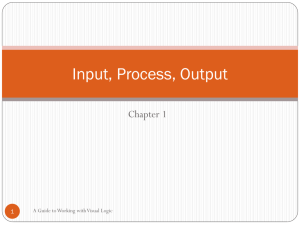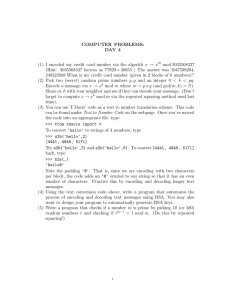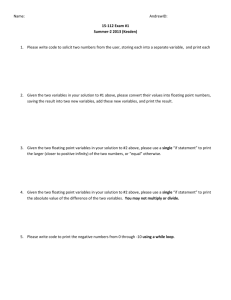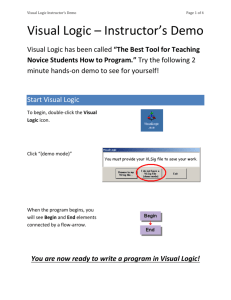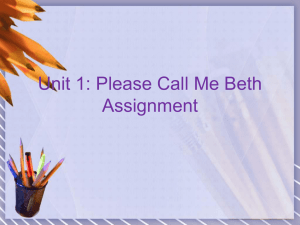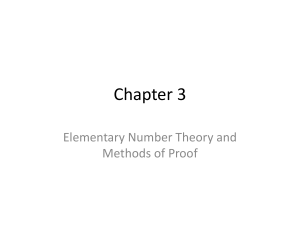Visual Logic Chapter1
advertisement
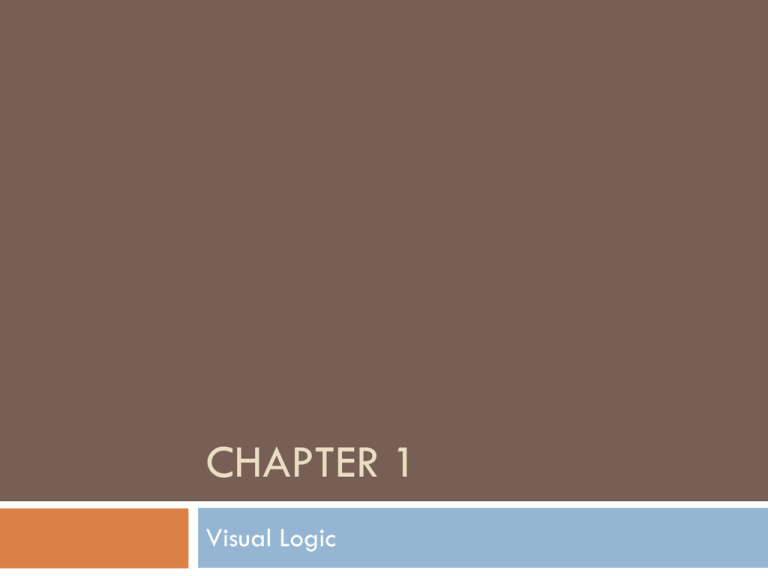
CHAPTER 1 Visual Logic Computer Program Solution to a problem. How can my customer purchase products from the Internet? Most do 3 things Input data Process data Output data Input Process Output Writing a Computer Program Determining what the problem is Creating a logical solution to solve a problem Implementing that solution Verify the solution is correct Everyday examples of algorithms Directions to bake a cake Direction for game Difference Between Data and Information 500 Data is numbers, character, and/or images without context Order 500 t-shirts Information is data that has been processed Logic and Syntax Compare building software application to a house. What are the requirements Design Construct Check Algorithm – logical blueprint for software Visual Logic Graphics of flowcharts (graphical representation of algorithm Utility of pseudo code ( min. syntax description of algorithm) Errors 6 Two Kinds Syntax Violate the rules of the language More difficult to do with Visual Logic than Java Begin with the easy more to more difficult Logic Violate the rules of the problem Your thinking is off You can do this anytime First Program Hello World Flowchart Symbols Creating Hello World Next Step Almost There You Did It Input Input Statement Accepts data and stores into a variable Variable Storage location Can be accessed and changed by developer code Has a name and a value Second Program Hello Name Program Formats Value Written Format Programming Format Comment String Hello World “Hello World” Use quotes to delimit strings Percent 15% 0.15 Use decimal format Dollars $300 300 Dollar signs not allowed Large numbers 12,345,678 12345678 Commas not allowed Weekly Paycheck Program Weekly Paycheck Program Specifics Accepts the hours worked Accepts the hourly rate for an employee Will calculate and display the appropriate pay amount due Step 1: Input What is the input needed Step 2: Processing What calculation must be performed Hours and Rate Hours * Rate Step 3: Output Expressions A value-returning code element X=A+B Assignment statements are use to perform calculations and store the results Expression is evaluated and stored in a variable Operator Precedence Operation Operator Expression 1 Result 1 Expression 2 Result 2 Exponentiation ^ 5^2+1 26 5 ^ (2 + 1) 125 Multiplication * 1+3*7 22 (1 + 3) * 7 28 Division / 8 +4/2 10 (8 + 4) / 2 6 Integer division \ 12 \ 4 3 17 \ 3 5 Integer remainder Mod 12 Mod 4 0 17 Mod 3 2 Addition and subtraction +- 4–5+2 1 4 – (5 + 2) -3 Java will handle exponentiation and division differently Weekly Paycheck Program Intrinsic Functions Predefined commands that provide developers with common, helpful functionality Function for Visual Logic Example Result FormatCurrency(12345) $12,345.00 FormatCurrency(.02) $0.02 FormatPercent(0.0625) 6.25% FormatPercent(0.75) 75.00% Abs(-3.3) 3.3 Abs(5.67) 5.67 Int(3.8) 3 Round(3.8) 4 Random(5) A random integer between 0 and 4 Random(100) + 1 A random integer between 1 and 100 Java handles these differently Rose by Any Other Name Paulette has just planted a large rose garden that she wants to fertilize. She knows the area of her rose garden in square feet, but the fertilizer is measured by the square yard. Write a program that converts square feet to square yards.

